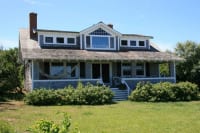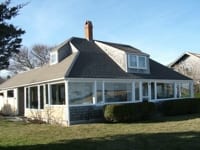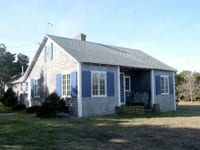Tucker – Johnson “The Little House”
![]() The Tucker “Little House” was built around 1910 by Margaret Doyle from New York. An artist, she later sold the property in 1930 to another artist and friend, Gertrude Howe from Hastings On the Hudson, New York for $3,000. Gertrude’s children, Bobbi Tucker and Priscilla Johnson inherited the property in 1996.
The Tucker “Little House” was built around 1910 by Margaret Doyle from New York. An artist, she later sold the property in 1930 to another artist and friend, Gertrude Howe from Hastings On the Hudson, New York for $3,000. Gertrude’s children, Bobbi Tucker and Priscilla Johnson inherited the property in 1996.
The original structure only had a dirt floor, wood stove, and one bunk. Today, the Little House has a full kitchen, round fireplace, dining room, and two sleeping bunks up in the Crow’s Nest. The 8′ panoramic window facing the ocean provides breathtaking views. The Little House is only 30′ from the edge of the Bluff and looks straight below to the [Read more …]
Tucker – Johnson “The Studio”
![]() Overlooking the Atlantic ocean, sandy beaches, and the ancient Nauset Marshes is a group of weathered grey buildings that have remained largely unchanged for 80 years. Although they originally only deserved the description of “duck shacks” they now have all modern amenities except that some are still partially supported upon locust posts. Mansions have grown up around them but their 180-degree view of the sea from a 50-foot high bluff is equal to any of those. The morning sunrises from the shining water to light their faces and the golden evening sunset spreads out over the lawn. They are in a spectacular setting.
Overlooking the Atlantic ocean, sandy beaches, and the ancient Nauset Marshes is a group of weathered grey buildings that have remained largely unchanged for 80 years. Although they originally only deserved the description of “duck shacks” they now have all modern amenities except that some are still partially supported upon locust posts. Mansions have grown up around them but their 180-degree view of the sea from a 50-foot high bluff is equal to any of those. The morning sunrises from the shining water to light their faces and the golden evening sunset spreads out over the lawn. They are in a spectacular setting.
In later summers, Marcia, an artist, continued her illustration [Read more …]
Strickler/Pattison “Foxtrot”
 The Strickler/Pattison cottage was built around the 1920s as a fisherman’s cottage. It consisted of three very small bedrooms, a small kitchen, and a living room. Its walls were stuffed with horsehair and newspaper as primitive insulation, and a wood-burning stove provided heat in the colder months. The cottage was originally set far back from the bluff, and a town road known as Cliff Road ran between it and the ocean. Eventually, erosion took enough of the bluff so that Cliff Road no longer exists, and the cottage is now about 50 feet from the bluff.
The Strickler/Pattison cottage was built around the 1920s as a fisherman’s cottage. It consisted of three very small bedrooms, a small kitchen, and a living room. Its walls were stuffed with horsehair and newspaper as primitive insulation, and a wood-burning stove provided heat in the colder months. The cottage was originally set far back from the bluff, and a town road known as Cliff Road ran between it and the ocean. Eventually, erosion took enough of the bluff so that Cliff Road no longer exists, and the cottage is now about 50 feet from the bluff.
The cottage was owned by the Smiths in the 1960s, and then by the Mickles in [Read more …]
Calderwood
 The Calderwood cottage was built in 1880 by a woman from Kansas City who used it in the summertime. In the garage, there was a horse stall and a place for a carriage, as well as a 3 hole lavatory (outhouse). Next to the garage was a windmill for pumping water from a well. The cement stanchions for the tower still exist. The 10′ diameter well hole was filled in by Mr. Calderwood for safety. The cottage was built of first-cut pine tongue & groove which made it strong. The driveway for the cottage is off Cliff Road; most of Cliff Road eroded from the top of the Bluff in the [Read more …]
The Calderwood cottage was built in 1880 by a woman from Kansas City who used it in the summertime. In the garage, there was a horse stall and a place for a carriage, as well as a 3 hole lavatory (outhouse). Next to the garage was a windmill for pumping water from a well. The cement stanchions for the tower still exist. The 10′ diameter well hole was filled in by Mr. Calderwood for safety. The cottage was built of first-cut pine tongue & groove which made it strong. The driveway for the cottage is off Cliff Road; most of Cliff Road eroded from the top of the Bluff in the [Read more …]
Tenney “Windward”

“Windward” was built in 1916 to 1917 and completed for occupancy in the summer of 1918. Source for the history of the cottage was Constance Tenney who was 11 years old in 1918 and my father, Captain Joseph F. Tenney, USN (Retired), who was eight years old at the time. When the cottage was completed there was only one cottage to the north owned by Richardson (MS. Marvel rented the cottage), now owned by the Calderwood family.
To the south were eight cottages and the old camp:
- David Young’s cottage (caretaker of the old camp)
- Farnham’s cottage
- Callahan’s (now owned by [Read more …]
Oberteuffer
![]() The Oberteuffer house was completed in 1941. Contracts were let in 1939 and the grading began in 1940. The grading and draining of the lot were done by Eddie Elnathan Eldredge of Chatham, and little Teddy Oberteuffer rode on the bulldozer. The design of the house was done by a professor of architecture at Ohio State University, Gilbert Coddington. Gilbert had never seen the ocean but was able to work from photographs of the site and the intended view and produced the design that is largely unchanged over the ensuing 70 years. It is interesting to note that when the house was originally sited on the lot the main supporting beam [Read more …]
The Oberteuffer house was completed in 1941. Contracts were let in 1939 and the grading began in 1940. The grading and draining of the lot were done by Eddie Elnathan Eldredge of Chatham, and little Teddy Oberteuffer rode on the bulldozer. The design of the house was done by a professor of architecture at Ohio State University, Gilbert Coddington. Gilbert had never seen the ocean but was able to work from photographs of the site and the intended view and produced the design that is largely unchanged over the ensuing 70 years. It is interesting to note that when the house was originally sited on the lot the main supporting beam [Read more …]